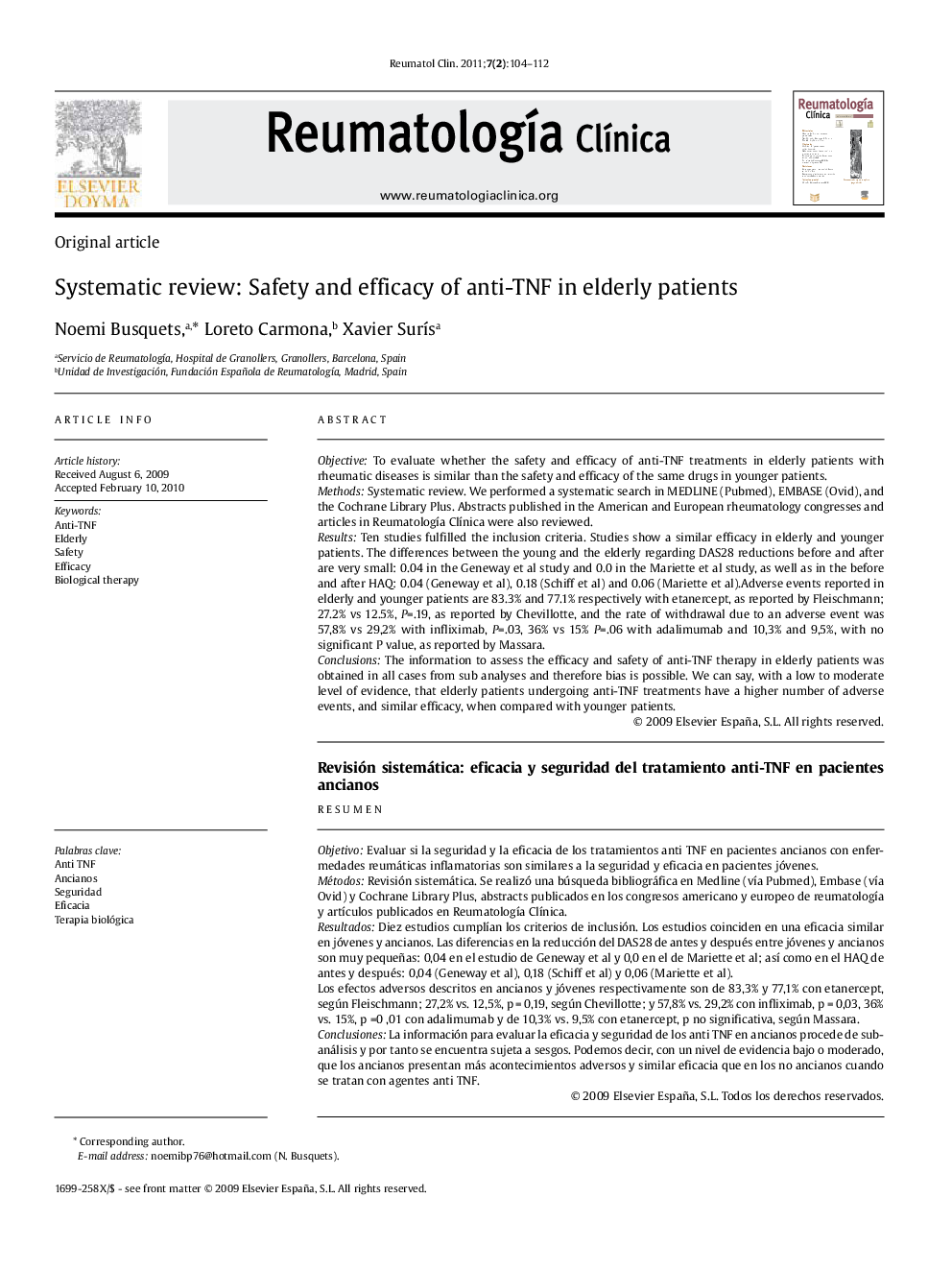| Article ID | Journal | Published Year | Pages | File Type |
|---|---|---|---|---|
| 3384688 | Reumatología Clínica (English Edition) | 2011 | 9 Pages |
ObjectiveTo evaluate whether the safety and efficacy of anti-TNF treatments in elderly patients with rheumatic diseases is similar than the safety and efficacy of the same drugs in younger patients.MethodsSystematic review. We performed a systematic search in MEDLINE (Pubmed), EMBASE (Ovid), and the Cochrane Library Plus. Abstracts published in the American and European rheumatology congresses and articles in Reumatología Clínica were also reviewed.ResultsTen studies fulfilled the inclusion criteria. Studies show a similar efficacy in elderly and younger patients. The differences between the young and the elderly regarding DAS28 reductions before and after are very small: 0.04 in the Geneway et al study and 0.0 in the Mariette et al study, as well as in the before and after HAQ: 0.04 (Geneway et al), 0.18 (Schiff et al) and 0.06 (Mariette et al).Adverse events reported in elderly and younger patients are 83.3% and 77.1% respectively with etanercept, as reported by Fleischmann; 27.2% vs 12.5%, P=.19, as reported by Chevillotte, and the rate of withdrawal due to an adverse event was 57,8% vs 29,2% with infliximab, P=.03, 36% vs 15% P=.06 with adalimumab and 10,3% and 9,5%, with no significant P value, as reported by Massara.ConclusionsThe information to assess the efficacy and safety of anti-TNF therapy in elderly patients was obtained in all cases from sub analyses and therefore bias is possible. We can say, with a low to moderate level of evidence, that elderly patients undergoing anti-TNF treatments have a higher number of adverse events, and similar efficacy, when compared with younger patients.
ResumenObjetivoEvaluar si la seguridad y la eficacia de los tratamientos anti TNF en pacientes ancianos con enfermedades reumáticas inflamatorias son similares a la seguridad y eficacia en pacientes jóvenes.MétodosRevisión sistemática. Se realizó una búsqueda bibliográfica en Medline (vía Pubmed), Embase (vía Ovid) y Cochrane Library Plus, abstracts publicados en los congresos americano y europeo de reumatología y artículos publicados en Reumatología Clínica.ResultadosDiez estudios cumplían los criterios de inclusión. Los estudios coinciden en una eficacia similar en jóvenes y ancianos. Las diferencias en la reducción del DAS28 de antes y después entre jóvenes y ancianos son muy pequeñas: 0,04 en el estudio de Geneway et al y 0,0 en el de Mariette et al; así como en el HAQ de antes y después: 0,04 (Geneway et al), 0,18 (Schiff et al) y 0,06 (Mariette et al).Los efectos adversos descritos en ancianos y jóvenes respectivamente son de 83,3% y 77,1% con etanercept, según Fleischmann; 27,2% vs. 12,5%, p = 0,19, según Chevillotte; y 57,8% vs. 29,2% con infliximab, p = 0,03, 36% vs. 15%, p = 0,01 con adalimumab y de 10,3% vs. 9,5% con etanercept, p no significativa, según Massara.ConclusionesLa información para evaluar la eficacia y seguridad de los anti TNF en ancianos procede de subanálisis y por tanto se encuentra sujeta a sesgos. Podemos decir, con un nivel de evidencia bajo o moderado, que los ancianos presentan más acontecimientos adversos y similar eficacia que en los no ancianos cuando se tratan con agentes anti TNF.
